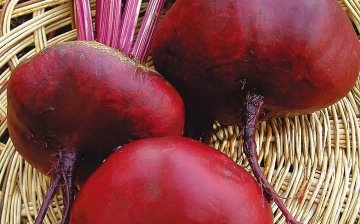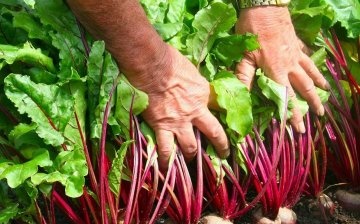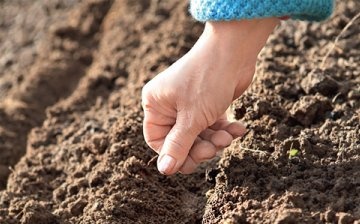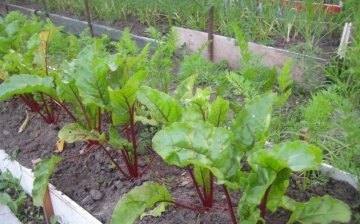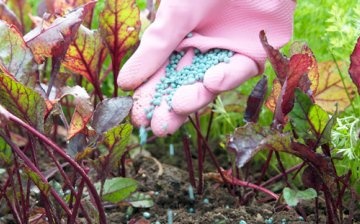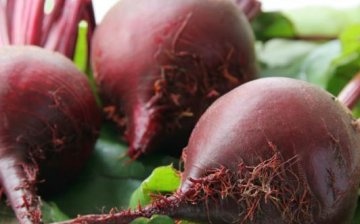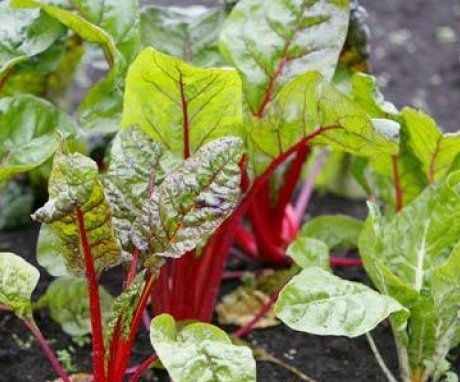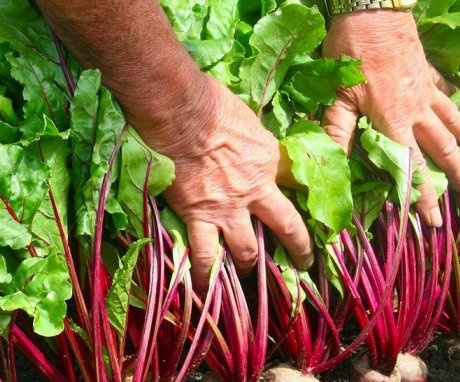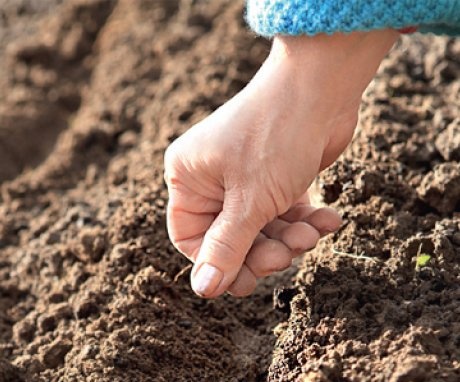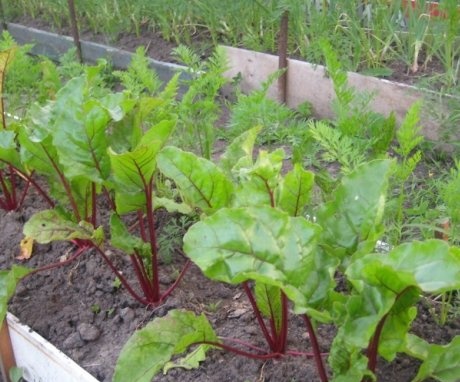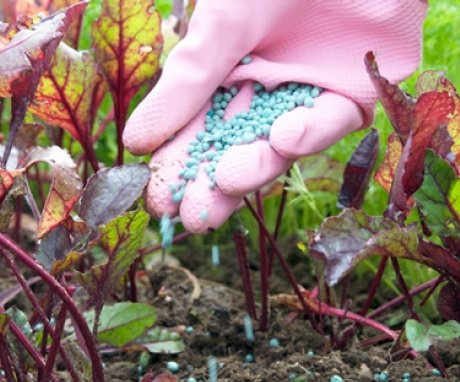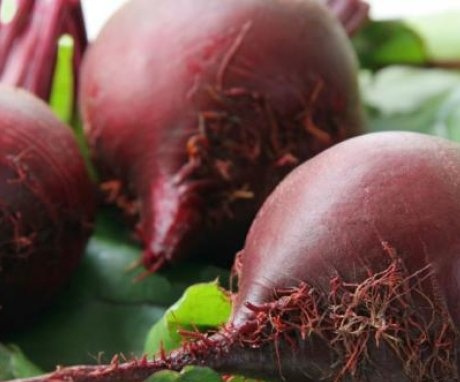Growing beets in the country is quick and easy
Beets are loved by many people for their taste and healthiness. Many dishes, for example, borscht or vinaigrette, cannot even be imagined without beets. Moreover, its nutritional value is very high. The root vegetable can be consumed both in the form of juice and in baked, fried or boiled form, and the young tops, after having dried them, can be used as a seasoning for ready-made dishes in winter, since they are also rich in nutrients. Some summer residents practice this method: immediately after harvesting, fresh juice is squeezed out of root crops.
The beets we eat belong to the "canteen" species and belong to the haze family. The root crop lives for two years, the seeds are contained in dry and tough fruits, so it is completely impossible to remove them. Root crops are connected into glomeruli, and they are sown by summer residents. Several plants emerge from each ball. It is because of this that the beets need to be thinned out. Otherwise, the plants will be too crowded.
Content.
- What time to plant beets
- What soil is suitable for beets
- Seed preparation for sowing beet seeds
- How to grow seedlings?
- How to care for a root crop?
- Beet thinning and harvesting
What time to plant beets
In order for the seeds to germinate, a temperature of five degrees is required, in three weeks the first shoots will appear. At ten degrees, the process will accelerate, and small plants can be seen in ten days. At fifteen - in five or six days, and if the thermometer rises above twenty, then the sprouts will turn green in three days. Based on this, it is worth focusing on the landing time.
Mid-May is the most acceptable time for planting beets, but if it's cold, then you can plant at a later date.
In the latter case, the seeds must be prepared. If there are no weeds, and the weather is warm, then late planted beets sprout well, and in terms of yield and quality they are not inferior to early plantings.
Remember that the spring cold snap has a very negative effect on the sprouts, provoking the appearance of flowering.
What soil is suitable for beets
To grow a good crop, it is necessary to water the beets frequently and abundantly during the first germination period, and water is also needed to increase the number of leaves. If the root crop is well rooted, it can easily withstand a short drought. But excess moisture can reduce the growth rate and yield, therefore, in places where the weather does not please with sunny days, it is better if you grow a root crop, then only on the ridges.
There is no better soil than loamy, light or suspended for a plant, since there are enough organic substances in them.
This root crop is one of the most demanding on the fertility and composition of the earth. The humus-rich and loose soil is perfect for sowing. The arable layer should be 20 cm.
Under suitable conditions and fertile soil, the plant can also be grown in flat areas. Just provide for a 45 cm wide passage. Dig the soil to the full depth of the earthen layer, while not turning the podzol part inside out. It is extremely important to turn and crush the soil layers.This is necessary so that tenacious weeds are at the very depth of the layer. The beds are created in the direction from north to south. It is important to break up all the clods in order to get loose soil.
Preparation for sowing beet seeds
To check the quality of the seeds, they must be germinated:
- Take a flat container, put a damp cloth in it and place 50 seeds on a rag.
- Cover them with another damp cloth.
- By the number of germinated seeds, you can easily determine the percentage of germination of this batch of seeds.
- Seeds of the first class usually germinate at 80%, germination lasts from three to five years.
There are quite traditional methods of accelerating the rate of sprouting and increasing the yield of beets. For example, you can soak the seeds in water that is about 15 degrees Celsius for one day. Just remember to change the water every three hours. There is a similar method. Only in this case, you need to wait until the seeds germinate, and then plant the germinated ones in a moist soil.
The most effective way is vernalization:
- Moisten the seeds with water. You can put them in a container and fill with water in a 1: 1 ratio.
- Leave the seeds for 32 hours and then pour out the water.
- After three days, put the swollen seeds in the refrigerator for 8 days, sprinkling them in a layer of three centimeters along the bottom of the box.
- This method must be applied 12 days before sowing.
About 19 grams of seeds per 10 square meters is normal seeding.
Do not bury the seeds, as the seeds will lack oxygen at great depths. It is also not worth sowing too small, for the seeds will simply be carried away by the wind, or they will dry out.
Cross seeding is rarely used. There is an opinion that with such a landing, leaving is easier. Make grooves in the ridge and sow the seeds, covering them with a layer of earth in half a centimeter, tamp and pour a layer of peat or humus... If the seeds are sown late, then the bottom of the furrow is watered and waited until it is absorbed. Only then can the seeds be sown.
How to grow seedlings?
If you want to get a harvest at the end of spring, you will need to build a greenhouse or, as a replacement, insulated beds, the creation of which will take much less time than the construction of greenhouse structures. It's easy to make them:
- You will need a small pit up to 40 centimeters deep and no more than one and a half meters wide.
- Put manure or garbage in it, the pile should rise 20 centimeters above the ground, sprinkle it on top with a twenty centimeter layer of soil.
- Such a pile will generate heat that will warm delicate plants.
- Burlap, film, matting will serve as additional protection from the cold.
Warmed ridges are arranged in early April, and in the period from April 15 to 30, seeds are sown, and seedlings are planted in the 20th of May. It will take a month to prepare the seedlings. It is obtained from the ridges. You need to sow early ripe varieties on them. They must first be soaked or vernalized.
When the weather is warm, the seedlings are planted in open soil, but covered with polyethylene at night. The seedling method helps to get the harvest of quality beets several weeks earlier.
How to care for a root crop?
Careful care is a must when growing beets. This root vegetable loves to "be capricious"! An important point is preventing the appearance of a crust on the soil. Make sure that the weeds do not strangle the sprouts, because harmful plants grow much faster than root crops. Keep the soil well hydrated, ensure optimal gas exchange and control the weeds - at the initial stage of beet growth, these are the main tasks of a gardener who wants to get a rich harvest.
To destroy weeds, you need to spray the plant with sodium nitrate, among other things, useful for root crops.
So, the solution must be mixed in the proportion: 2 g of saltpeter per liter of water. This is enough to process 1 sq. meter of soil. Remove remaining weeds by hand.
A huge role is played by loosening the crust on the soil, spraying with tractor kerosene (about 40 grams per square meter). This is necessary to tackle weed problems with minimal manual labor.
Some summer residents advise adding ordinary salt to the water for irrigation. As for the frequency of watering, if there is no rain, water twice 10 liters per square meter. m.After watering, loosen the soil, since water must penetrate to the very roots, and they lie at a depth of 15 cm.
Beet feeding:
- When the second pair of leaves has appeared on the sprouts, the first feeding of the root crops is carried out. Dry fertilizers are applied when the soil is loosened between the rows. One square meter will require eight grams of potassium salt fertilizer and ten grams of ammonium nitrate.
- When the rows are ready to close, it's time for the second feeding. Loosening in this case is also necessary. In this case, you will need to use a little more fertilizer.
Beet thinning and harvesting
Many root crops, including beets, are sown more densely than necessary for their normal growth and development. Sowing is specially made thicker, since due to weather conditions, death and damage of seedlings, not all seeds will sprout.
When planting densely, root crops take away nutrients from each other, and this can lead to a poor harvest and a decrease in the quality of the product.
Small and crooked roots in beets grown without thinning are provided. Because of this, it is really necessary to thin out the beets. This is an ambulance measure for root crops.
When decimation is done:
- Have two leaves appeared on the beets? This marks the beginning of the first decimation. 2 centimeters is the most acceptable distance between plants.
- When five leaves appear, the second thinning phase begins. Here the distance should already be larger - about five centimeters.
- Until the 15th of August, the third thinning is carried out. The gaps between root crops reach seven centimeters.
- Carefully monitor the timing of thinning, since if you are late to carry out such an important procedure, you risk losing part of the crop and deteriorating the quality of the rest. The best time for this procedure is after rain or watering. It is easier to pull the plants out of wet soil, and neighboring shoots will be less disturbed. In addition, transplanted plants will take root in wet soil much better than in dry soil.
There is an unspoken rule that during the first thinning process less viable and weakened shoots must be removed, and with subsequent thinning it is necessary to replant large and developed plants that are suitable for food. Instances showing even small signs of illness, it is best to throw it away.
By following all these rules, you can grow a large and high-quality harvest of tasty and large beets. But now the harvest is ripe. When to collect it?
It is necessary to start harvesting approximately 75 days from the day of sowing.
The collection of root crops ends until mid-September, that is, until the first frosts begin. In order for the beets to better retain their color, vitamins and all nutrients, you need to cut off the tops at a distance of three centimeters from the root. You can store root crops in cellars or basements, where the temperature does not rise above three degrees.
More information about growing beets can be found in the video.



